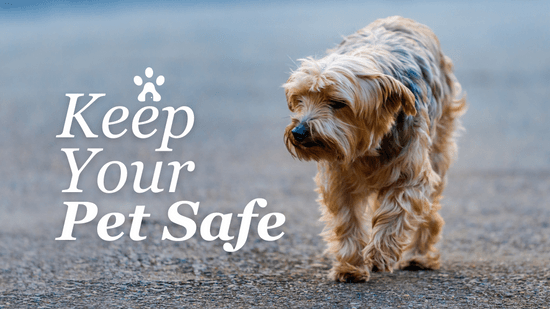How to Prevent Your Pet from Going Missing
)
As a pet owner, one of the most worrying situations you may face is the fear of your pet going missing. Whether it’s a cat darting out the door or a dog escaping the yard, pets can sometimes get lost unexpectedly. However, there are several proactive steps you can take to reduce the risk of this happening. By making sure your pet is properly identified, safe in their environment, and well-trained, you can significantly increase the chances of keeping your furry companion at home where they belong.
1. Ensure Your Home and Garden Are Secure
The first step in preventing your pet from going missing is making sure your home and garden are as secure as possible. Whether you have a garden or an apartment with access to the outside, it’s important to check for gaps or weak points that your pet could use to slip away.
Fencing: If you have a dog, check your garden fence for any gaps or areas that may have been weakened by wear or weather. If possible, secure your fencing so that your pet can’t dig or climb over it. Some dogs can be surprisingly resourceful when it comes to finding ways out.
Secure Gates and Doors: Ensure that gates and doors are always closed and latched. Even a small crack can provide enough space for a curious pet to escape.
Balcony Safety for Cats: If your pet is a cat, consider installing netting or special screens on balconies or windows to prevent them from jumping or falling.
By taking these precautions, you create a safe, controlled environment for your pet that minimises their chances of running off.
2. Proper Identification: The Importance of Tags and Microchips
One of the most important things you can do for your pet’s safety is to ensure they are properly identified. If your pet does manage to get lost, proper identification can make it much easier for someone to return them to you.
Collar with ID Tags: Ensure your pet wears a collar that includes an ID tag with your current contact details. This is especially important for outdoor pets who may be away from home for extended periods. Be sure to check the tag regularly to ensure it’s still secure and the contact information is up-to-date.
Microchipping: Microchipping is a permanent form of identification. The chip, which is about the size of a grain of rice, is implanted under your pet’s skin and can be scanned by animal shelters, vets, or authorities. It’s vital to ensure your contact information is registered and up to date with the microchip provider.
GPS Trackers: For added peace of mind, consider using a GPS collar or tracker that allows you to track your pet’s location via a mobile app. This is especially useful if your pet is prone to roaming or is often outside.
By combining a collar and microchip, you increase your chances of being reunited with your pet should they go missing.
3. Keep Your Pet Calm in Stressful Situations
Sometimes, pets escape not because they want to, but due to anxiety or fear. Events like loud noises, fireworks, or changes in their environment can cause your pet to panic and run away. Here’s how to help your pet stay calm:
Create a Safe Space: Set up a quiet, secure place where your pet can retreat when feeling anxious. This could be a cosy bed in a quiet room, away from loud noises or stressful situations.
Desensitisation: Gradually expose your pet to situations that might trigger anxiety, such as fireworks or thunderstorms, to help them build resilience. However, be sure to do this slowly and with positive reinforcement to avoid overwhelming them.
Calming Products: Consider using calming aids such as pheromone diffusers, anxiety wraps, or calming collars that can help reduce your pet’s stress. There are also anxiety-relieving treats and sprays available that can be effective in some cases.
Training: Teaching your pet to respond to basic commands such as ‘come,’ ‘stay,’ or ‘sit’ can be invaluable in situations where they may be tempted to flee. These commands not only help control your pet’s behaviour but can also help you redirect them if they become agitated.
By addressing your pet’s anxiety, you can prevent them from running away in moments of panic.
4. Training Your Pet to Prevent Escape
Training is not only beneficial for teaching your pet manners and obedience but also for preventing unwanted behaviours such as running away.
Recall Training: One of the most important commands you can teach your pet is ‘come.’ This simple yet essential command can help you call your pet back to safety if they start to wander off. Start training your pet in a secure environment, using positive reinforcement like treats and praise.
Leash Training: For dogs, leash training is vital for walks and outings. Never let your dog off-leash in an unsafe area or outside the yard. Always supervise your pet when outside, especially if they are prone to running away or chasing after something.
Boundary Training: Teaching your dog boundaries, such as not leaving the yard or stepping out of the house without permission, can significantly reduce their chances of running away. Consistent training and rewards help reinforce these boundaries.
Socialisation: Exposing your pet to new people, pets, and environments can help build confidence and reduce the likelihood of them becoming stressed or scared, which can sometimes lead to escape attempts.
Training takes patience, but it’s one of the best ways to ensure your pet stays safe and under control.
5. Regular Check-ups and Monitoring
Regular health check-ups at the vet are essential not only for your pet’s overall health but also for ensuring they are properly cared for. Here are a few ways regular visits can help prevent your pet from getting lost:
Health Issues: Sometimes, a pet may be more likely to wander or escape due to health issues, such as pain, confusion, or cognitive decline. Regular vet visits can catch these issues early and ensure your pet is healthy.
Behavioural Changes: If your pet suddenly starts showing signs of anxiety, aggression, or disorientation, a vet check-up can help determine if there’s an underlying medical cause. Treating these issues can prevent them from becoming a safety concern.
Parasite Prevention: Fleas, ticks, and other parasites can sometimes cause pets to behave erratically. Regular treatments and flea preventatives can keep your pet comfortable and less likely to stray in search of relief.
A healthy, well-cared-for pet is less likely to run off due to pain or discomfort, so keep up with their vet appointments and health screenings.
6. Knowing What to Do if Your Pet Goes Missing
Despite all precautions, there’s always a chance that your pet may slip away. If your pet goes missing, it’s important to act quickly:
Notify Local Shelters and Vets: Contact your local animal shelters, vets, and pet microchip registries as soon as you realise your pet is missing. Provide them with detailed information about your pet, including their microchip number, collar ID, and any distinguishing features.
Spread the Word: Inform your neighbours, friends, and family members about your missing pet. Post on social media platforms, and use local lost pet groups or apps to increase the chances of finding them.
Put Up Posters: Create lost pet flyers with a clear photo and detailed description, including your contact information. Place them in local parks, vet clinics, and community centres.
Keep Searching: Be persistent in your search. Pets often stay close to home, so continue to check local shelters, parks, and neighbourhoods where your pet may have gone.
The faster you act, the higher the chances of being reunited with your pet.
By following these practical steps, you can significantly reduce the chances of your pet going missing. A combination of security, identification, training, and proper care will keep your pet safe, allowing you to enjoy many happy years together.
| Tags:Pet Safety |
)
